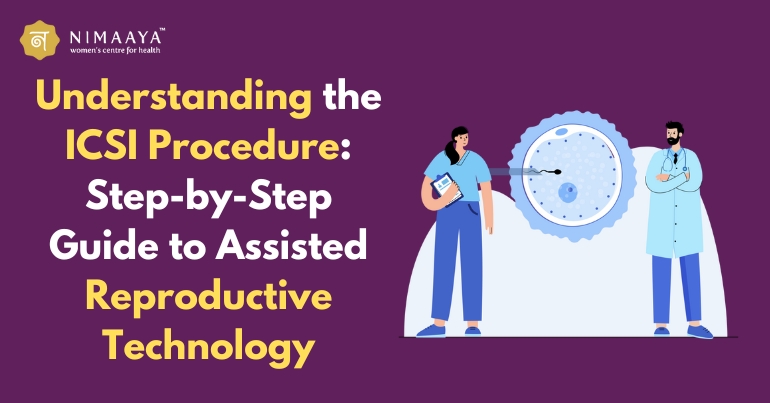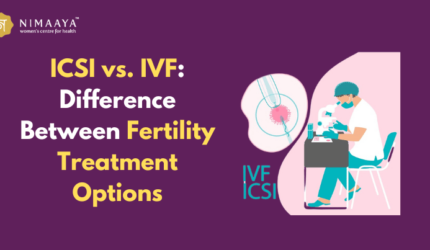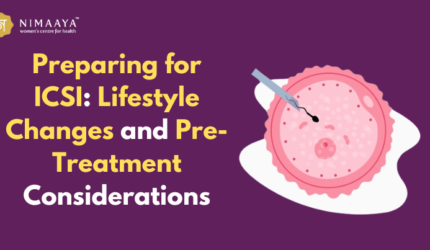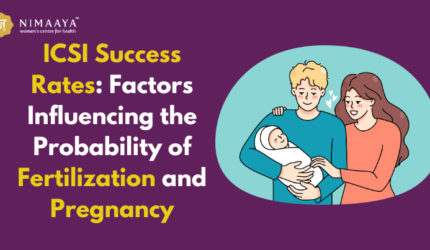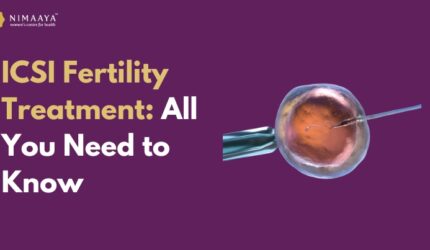In our previous blog, we studied what the term ICSI means, the process, icsi procedure success rates, the risk involved, and when there is a need.
In this blog, we will study icsi procedure step by step, so you can gain in-depth knowledge that will help you understand and better prepare for the treatment if you are considering it.
Let’s explore icsi procedure step by step:
1. Starting Phase
To begin the process, females will need to undergo fertility testing, including an examination of the uterus and fallopian tubes and hormonal assessment. In addition, the male will undergo semen analysis.
Once all the results and tests are reviewed, your doctor will have a clear understanding of your health condition and prescribe you accordingly.
At Nimaaya, after all the tests are conducted, you will be asked to administer the hormonal injection at home and instructed to take any medicine if required.
2. Ovarian Stimulation Phase
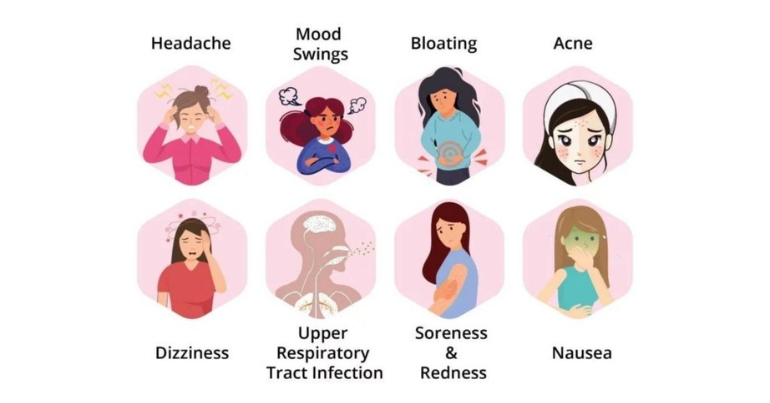
In this step, you need to stimulate your ovaries to produce as many follicles, egg-containing vesicles on your ovaries, administering hormonal drugs on 2 or 3 days of your period and daily for 9 to 12 days.
It is observed that during a normal menstrual cycle, several follicles start to grow and develop, with usually one egg proceeding to produce a mature egg. The goal is to have all developing follicles proceed to have mature eggs, which can be retrieved and proceed to have the highest chance of success.
Remember throughout this procedure, your ovaries will be monitored to see how they will respond to the hormonal medications. After every 9 to 12 days of stimulation, you will be asked for blood tests and ultrasound.
After the results, doctors may recommend medications accordingly and prepare the egg for ovulation, where eggs will be allowed to be released from the wall of the follicles so that the doctor can do the egg retrieval process.
3. Egg Retrieval and Semen Collection
After 36 hours of the trigger shot, a minor surgery procedure is performed to retrieve the mature eggs from your follicle. The process will begin with doctors using ultrasound guidance to let needles pass into your pelvic cavity for egg retrieval. This procedure takes about 15-20 mins.
On the same day of egg retrieval, the partner’s semen will also be collected. It is recommended to avoid any contact with body fluids before this. The collected semen is allowed to liquefy for about 30 minutes, followed by a washing process to remove debris, immobile sperm, and other unwanted substances. This processed semen then undergoes a semen analysis to determine the quality of sperm. It is done to decide which infertility method is to be chosen, IVF or ICSI.
IVF is usually preferred when the semen sample is of good quality, as it enhances the chances of successful fertilization.
In the case of IVF, the egg and sperm are mixed and allowed to be fertilized on their own in a laboratory dish. On the other hand, ICSI involves the selection of a single healthy sperm, which is selected and injected directly into mature eggs to facilitate fertilization.
4. ICSI Fertilization
As mentioned above, ICSI involves the selection of a healthy sperm for each mature egg. The IVF specialist will repeat this procedure for each egg. Then, the following day, the fertility center will check for the fertilization status.
5. Embryo Culture
After the eggs and sperm are fertilized and become embryos, they will be cultured in a unique incubator for 5-6 days until they develop and grow to the blastocyst stage, where they will be ready to transfer into and implant in the lining of your uterus.
The embryo process is sensitive and requires the embryologist to maintain environmental conditions and operate advanced technical equipment to maintain a stable environment to let embryos grow and develop properly.
6. Embryo Transfer
The stage after embryo culture is icsi embryo transfer, where the embryologist will select one or more blastocysts to be transferred back into your uterus to grow and develop into a baby.
Under ultrasound guidance, the embryologist will load your selected blastocyst into your uterine cavity wall so that it can implant into the wall of the uterus and begin to grow and develop.
To confirm pregnancy, it is recommended to use an ultrasound after two weeks.
7. Embryo Freezing
Any excess embryo of good quality can be preserved through a rapid freezing technique. This process prevents the formation of ice crystals in the embryos by freezing them rapidly, ensuring their preservation in deep frozen frozen storage.
When stored in a high-quality and well-mannered laboratory, the frozen embryo can maintain its quality over an extended period.
These frozen embryos will be valuable resources in the future if you decide to pursue pregnancy later in life.
ICSI Procedure Painful
9 out of 10 women don’t experience pain throughout any fertility treatment. This is because the process involves giving anesthesia and insertion of sperm through placing a catheter and experiencing slight body pain or weakness.
In some cases, there are higher chances of females’ health getting serious. We suggest consulting an IVF specialist without giving it a second thought.
Key Takeaways
To sum up, the ICSI procedure is cost-effective and can be opted for by couples facing any difficult issues while conceiving a baby. It is recommended to consult and have a counseling session with doctors at Nimaaya when you choose an ICSI procedure.
It is because they will properly guide you throughout the procedure and let you know your concerns such as is the procedure painful and what are the mental and emotional challenges couples as an individual have to go through.
Moreover, if not icsi then what are the other fertility treatments that couples can opt for and would fit within their budget or not? You can trust us! Your dream to expand your family will be successful with our specialists, Dr. Pooja Nadkarni Singh, and Dr. Yuvrajsingh Jadeja. Their guidance guarantees a smooth ICSI or any other fertility treatment journey.

